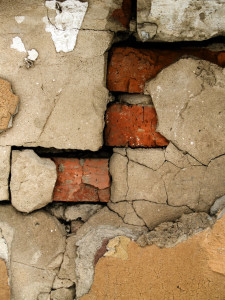 Because of the inherent nature of the materials used to build traditional masonry chimneys, with the lone exception being those that have been adequately waterproofed, water is naturally going to soak into the bricks and mortar. This water intrusion ultimately speeds up the weathering process and causes premature aging. The mortar between the bricks cracks and crumbles over the course of time because of this constant exposure to the elements. It’s not only unpleasant looking, but also could be a sign of serious damage. The damaged mortar eventually crumbles and falls away, leaving open areas between the bricks that will allow even more water to invade your chimney. This leads to even more issues. If you’ve noticed any of this happening to your chimney, fear not.
Because of the inherent nature of the materials used to build traditional masonry chimneys, with the lone exception being those that have been adequately waterproofed, water is naturally going to soak into the bricks and mortar. This water intrusion ultimately speeds up the weathering process and causes premature aging. The mortar between the bricks cracks and crumbles over the course of time because of this constant exposure to the elements. It’s not only unpleasant looking, but also could be a sign of serious damage. The damaged mortar eventually crumbles and falls away, leaving open areas between the bricks that will allow even more water to invade your chimney. This leads to even more issues. If you’ve noticed any of this happening to your chimney, fear not.
MAKING NECESSARY REPAIRS
The damaged, old and loose mortar on your chimney can be removed from the joints between the bricks and then replaced with new mortar or masonry repair caulk during a process called repointing. Only a skilled professional should repoint a chimney, as the work requires an experienced hand. During this process, the existing mortar joint is cut to an appropriate depth and the joint is then packed with new mortar. The new mortar joint is then tapered to create a concave surface that directs water out of the joint.
SEPARATING THE GOOD FROM THE BAD
A professional repointing job, using proper materials, will increase your chimney’s lifespan while at the same time enhancing its appearance. Repointing is far more than just slapping some mortar into your chimney’s cracks, however. The process requires different skills than your everyday, run-of-the-mill masonry; it’s not that surprising that even brick masons who have years of experience in the trade might not have significant experience repointing chimneys. The biggest challenge to repointing a chimney is simply determining just how much mortar is damaged and removing it without causing additional damage. Removing even a smidge too much can further compromise the structure of your chimney. Knowing how much is enough takes a skilled eye.
COMPLETING THE REPAIR PROCESS
Once the damaged mortar has been removed, the new mortar has to be mixed. The new mortar should be as similar to the original mortar as possible so as to avoid premature mortar deterioration down the road. The freshly mixed mortar is then placed between the brick via a layering process involving gradual compacting and tooling to ensure that it adheres to the old mortar in the best way possible. This is another place where a skilled hand is invaluable, as this process isn’t for a greenhorn brick mason.
While all masonry will need repointing at some point, chimneys are particularly susceptible to water damage, as their location subjects them to constant exposure to the elements. Their location, high atop your roof, also makes them difficult to monitor for signs of damage. This is yet another reason to have your chimney inspected prior to the beginning of the heating season. Timely chimney repair will most certainly save you money, and who doesn’t like that? The CSIA-certified technicians at Old Smokey’s Fireplace and Chimney will give you peace of mind in knowing that your chimney will be safe and sound for many years to come.
